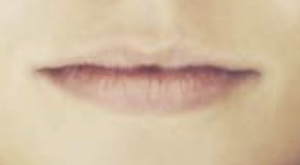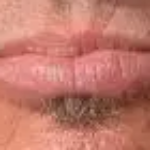Award Winning Author
Face Reading with Before & After Photos
Is a Larger Lower Lip Better?
Swollen Lips, Beauty and Health

Large bottom lip
Having a lower lip that’s twice the size of your top lip is considered the most beautiful ratio for women according to a 2017 JAMA Plastic Facial Surgery study.1 This is a dramatic change from the past when evenly proportioned lips were the norm. Today most people have a less toned and therefore larger lower lip. Sometimes, as we see in the accompanying photo, it’s even tripled in size. While the lower lip is typically more flaccid, some people’s top lip is more swollen.
Until recent decades, people typically had small, toned lips of uniform size (bottom and top lip of comparable volume) with mouths as wide as the nostrils perched over them. You can ascertain this yourself by looking at historical beauties such as Queen Nefertiti, Michelangelo’s David and the Mona Lisa.
After considering the historical standard, let’s examine the causes, other than lip fillers, of today’s mismatched lips. Lastly we’ll look at solutions for regaining lip tone–and, correspondingly, digestive health–using traditional Chinese Medicine’s Five Elements.



And what about us ordinary folk? Do an online search of early black-and-white photography such as the following daguerreotype photos from the mid-1800s. Granted you’ll find exceptions, but you can quickly discern that until recent decades most people generally had smaller lips that were approximately uniform in volume.
Our Changing Lips
Two interesting studies corroborate the “plasticity” of our lips and mouth size. In the 1930s, a dentist, Dr. Weston A. Price, took thousands of photos of traditional peoples throughout the world to demonstrate that refined foods caused a shift in jaw and mouth sizes. More recently, Forrest Maready in Are You Crooked? offers a compelling photographic study of how contemporary mouths differ from what was the historical norm.
What the Mirror Reveals
Look at your family photo album to first ascertain your genetic proclivities. If your forebears were from a temperate zone, odds are they had relatively small lips that were uniform in size. If you have several generations of photos, note how progressively this is changing, even in one person’s life span.
Hormones Engorge Lips
While genetics helps determine lip shape, color and size, another factor is hormones. At puberty, girls’ lips enlarge, reflecting higher levels of estrogen. And when sexually aroused, both men and women have increased blood flow to the lips, causing them to temporarily engorge. This is why generous-sized lips can aptly suggest sensuality.
Conversely, as hormones decrease with age, lip size does as well. Making, perhaps, today’s Botox-inflated lips look incongruous on a senior. Furthermore, cold restricts blood flow and causes lips to temporarily contract, as you can observe on yourself. So even though Brad Pitt appeared to be freezing in the movie Seven Years in Tibet, his puffy lips blew that cover.
Toned Flesh Is a Measure of Health
So what’s at the root of today’s larger lips? Five Elements Face Reading offers insight. As the mouth is the starting point of the alimentary canal, it mirrors digestive health. More specifically, the top lip is a readout for the upper gastrointestinal tract and the bottom lip shows the state of affairs below the belt. And while problems occur through the whole GI tract, judging from today’s trend of larger lower lips, the colon is most challenged.
There’s compelling evidence from multiple disciplines that since the advent of the modern diet our digestive health has been compromised. This in turn has changed our appearance, and our definition of beautiful lips.
In my clients, I see a correlation between a less toned bottom lip and bowel issues. This is something you can see in yourself. For example, if you are constipated, it will probably be more expanded. Or after a large BM, your bottom lip will look more toned. Note how some foods increase the swelling.
In the photo below, we see variation between the top and bottom lip and also between the right and left sides. Divide this man’s lips into quadrants to see four distinct sizes. His top right is the smallest and the bottom right is the largest.

As clients make targeted dietary and lifestyle shifts, they regain lip tone, as you can see in the Before and After Photos blog. You’ll find information relevant to bottom lip irregularities at Metal Element; for the top lip, see the Earth Element.
If today your lips lack tone, not to worry, for here’s the good news. Gut cells regenerate every two to three days. So if you remove the triggers that cause your digestive unease, you can regain well-being and firm lips. And then flaunt your smackers!
An earlier version of this article appeared in Bare Essentials Magazine, Vol. 46
Photo credit for the first image: Bare Essentials Magazine.






This sounds ridiculous. Apparently my lips are not “toned” and that my ethnic background conflicts with my lip size. So I guess I ate too many hormones? Or is it tone? Or is it all baloney?
I invite you to experiment and then, perhaps, reassess. Note the variability of your bottom lip over time and even from day to day. Especially pay attention to how your diet can decrease or increase its volume. Also if you are constipated, it will probably be more pouchy (less toned). Or after a large BM, your bottom lip will look more toned. Track your changes and let us know what you discover.